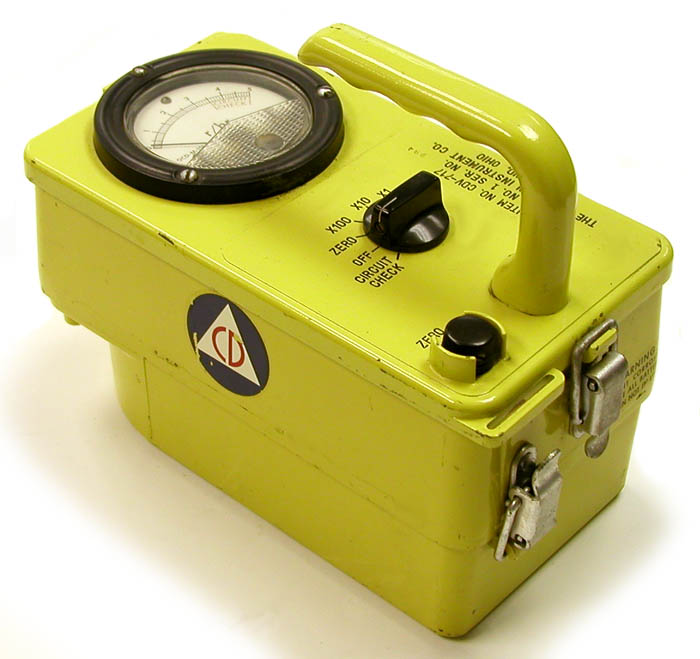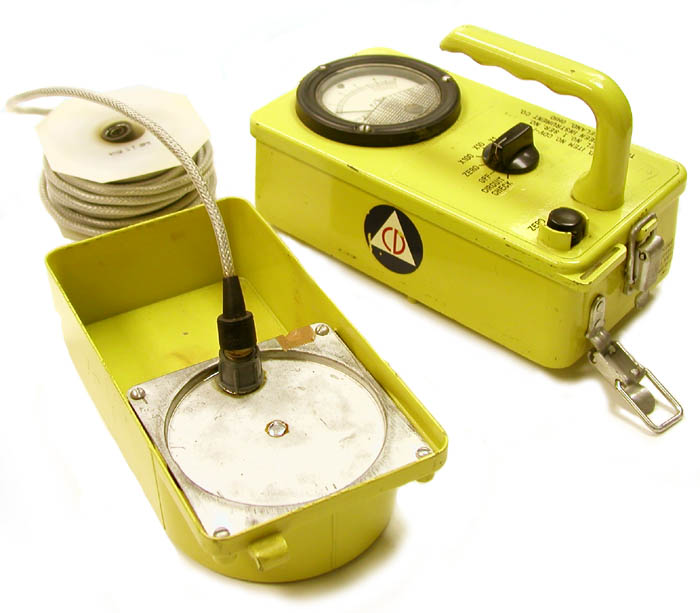CD V-717 Ion Chamber Survey Meter (ca. 1963)
The CD V-717 is a modification of the CD V-715 ionization chamber survey meter. Its operating characteristics and specifications are very similar to those of the CD V-715, except that the 717 has a removable hermetically sealed chamber that can be attached to 25 feet of cable. This gives the 717 the ability to make remote readings, e.g., with the chamber outside the monitoring station where it was used.


The bottom half of the case contains the ion chamber and a removable spool with 25’ of cable. The 717, like the 715, was transistorized and had two controls: a zero adjust knob and a range switch.
The example shown here is a Model 1 manufactured by Victoreen. I believe that this was the only version of the 717.
The purpose of this instrument is explained in the following quote from CPG 1-30 (FEMA 1981): "This instrument was designed for use by radiological monitors in WER stations during the early period following a nuclear attack. The purpose of the instrument is to decrease the radiation exposure to monitors by making it unnecessary for the monitor to leave his shelter in order to obtain an outside measurement."
The term "WER" refers to the Weapons Effects Reporting stations which had previously been referred to as Fallout Monitoring or Fixed Monitoring stations. According to CPG 1-30, they are facilities with fallout protection, reliable communications, instruments and trained monitors that are designated for the collection and reporting of weapons effects and radiological data to the local Emergency Operating Center (EOC).
Range: 0-0.5, 0-5.0, 0-50, 0-500 R/h
Response time: 95% of final reading in nine seconds, two minute warm up
Size: 4.5” x 9” x 7”
Weight: 5.25 pounds
Batteries: One 1.5 volt
Battery life: 150 hours of continuous use
Materials: The case is aluminum while the panel and handle are die cast zinc
Manufacturers: Victoreen Inst. Co.
The Bendix Corporation seems to have been involved in the initial development of this device. The 1961 Annual Report of the Office of Civil and Defense Mobilization stated: "the Bendix Corp. initiated the modification of a standard CDV-715 radiation survey meter to provide a remote detector attachment for measuring dose rates at some distance from the meter." Similarly, an article in the January 1962 issue of Nucleonics indicated that this instrument was under development by Bendix and that the R&D designation being used was "CD-715BX" (not 717BX).
The earliest reference that I have found to the CD V-717 is in the 1963 Office of Civil Defense annual report wherein it is noted that 100,000 of these were ordered.
Since the specifications for the CD V-717 eliminated some of the problems encountered with the CD V-715, no retrofits were required.
Approximate Cumulative Procurement, Inventory and Distribution of CD V-717s*
| Fiscal Year | Procured | Inventoried | Distributed |
|---|---|---|---|
| FY 1962 | - | - | - |
| FY 1963 | 100,100 ordered. No delivery information. | ||
| FY 1964 | 100,100 ordered. No delivery information. | ||
| FY 1965 | 100,100 | 84,788 | 798 |
| FY 1966 | 100,100 | 94,647 | 5,453 |
| FY 1967 | 100,100 | 93,673 | 6,427 |
| FY 1968 | 100,100 | 91,790 | 8,310 |
| FY 1969 | 100,100 | 91,509 | 8,591 |
| FY 1970 | 100,100 | 90,529 | 9,571 |
| FY 1971 | 100,100 | 90,305 | 9,795 |
| FY 1972 | 100,100 | 90,043 | 10,057 |
| FY 1973 | 100,100 | ||
| FY 1974 | 100,100 | 20,913 | 79,187 |
*The numbers in the above table should be considered approximate. I compiled them from data in the Annual Statistical Reports of the OCDM, OCD and DCPA. By "procured," I mean delivered by the manufacturer to the OCDM, OCD or DCPA. "Inventoried" means stored in a Federal (rather than state) warehouse ready for distribution. "Distributed" means sent to the end user. The latter primarily means the states, but also various federal agencies and even foreign governments. The number of procured instruments may be greater than the combined number of inventoried and distributed instruments for a variety of reasons: some may have been sent back to the manufacturer, some may have been disposed of, the numbers might be incorrect, etc.
References
- Federal Emergency Management Agency. Guide for the Design and Development of a Local Radiological Defense Support System. CPG 1-30. June 1981.
- FEMA, Radiological Instruments: An Essential Resource for National Preparedness, CPG 3-1/September 1986.
- How Civil Defense Measures Harmful Radiation, Nucleonics, January 1962 p. 67-68;
- Instruction and Maintenance Manual Victoreen CD V-717 Model No. 1, 1964
